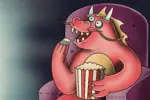Poor Phil Connors. No, not that Phil Connors. You know, Billy Murray’s character in the 1993 film “Groundhog Day,” the now-iconic movie that introduced wide-screen audiences to the dreaded time loop and to the song “I Got You Babe” by Sonny & Cher?
The plot is centered on a weatherman Phil Connors and his attempts to enter tomorrow after being stuck repeating one day of his life over and over again. A great day for Groundhog festivities takes a turn for the worse when a winter storm approaches, and Connors must learn selflessness and an appreciation for others to escape the time loop.
The success of the 1993 flick has turned time loops into a fiction trope that has been revisited by authors and filmmakers over the years. In 2019, the time loop has made another appearance on the big screen with the thriller, “Happy Death Day 2U,” and on the Netflix home screen with “Russian Doll.” Do people consider time loops a new genre in television, movies and stories, or is it just a recycled trope that hasn’t yet met its demise?
A time loop is a movie-plot device that features a main character randomly getting stuck in a loop where they are forced to relive the same day over again. The supporting cast is almost always unaware of the repetition of time, and that contrast is heavily emphasized throughout. Perhaps, time loops are just a subgroup of the time-travel genre, but its significance has grown consistently.
The history of time loops, technically, didn’t begin in 1993 with “Groundhog Day,” although the film is hailed as the OG of time loop movies. Instead, “12:01 PM,” by Richard A. Lupoff, takes that honor, as the Jonathan Heap-directed film was the first to push its protagonist into finding a way to escape the trial-and-error time loop. While it wasn’t a major box office success, “12:01 PM” was still a launching pad for “Groundhog Day” to reach its icon level.
https://www.youtube.com/watch?v=CASnLHyB2U8
So, why was “Groundhog Day” so successful, and how did it become a pop culture reference? The time loop serves as not only an intriguing conflict at the forefront of the film, but a catalyst for extreme character growth in 180 minutes.
Audiences crave character growth in films, and it is often what drives the entirety of any movie. Time loops settle down the background noise and action and focus on the character’s problem-solving skills, identification of personal flaws and creativity in explanation of what is going on.
Take “Russian Doll”: the main character dies over and over and is forced to repeat her 39th birthday. Out of annoyance and confusion at the events happening to her, she reopens her past secrets, explores hidden emotions and actively attempts to move past this one day. In short, time loops are a call to action for the protagonists.
2014’s movie “Edge of Tomorrow,” took the time loop to the battlefield to focus on the flaws of the main protagonist. In it, Tom Cruise’s character, Major William Cage, is forced to repeat the day before he is killed in combat over and over again. Seeking a way to defeat the extraterrestrial invaders, Cage teams up with special forces warrior Rita Vrataski (Emily Blunt) to improve his fighting skills. Without the time loop, there is no hero.
Time loops are both a conflict and a solution, and while the protagonist changes, the films are all similar in their blinkered view of the world. Murray, the main character in “Groundhog Day,” is a narcissist lacking conceptualizing skills. In “Happy Death Day,” a plot line involves a young woman who is vain and socially unaware.
Although these characters are far from being likable when first introduced, they are able to adapt to the stagnant time around them and discover simple truths previously unnoticed. Time loop movies are successful in producing the effect on the audience. To be honest, it feels good to watch unlikeable characters fail in their attempts to escape.
The main question remains the same: Is “Groundhog Day” a new movie genre that provides a pathway for the main character’s enlightenment? Or is it just a recycled plot theme that changes circumstances with each rotating movie title? Either way, with new recreations of this classic movie trope, it looks like the audience might be stuck in a time loop of their own.
















